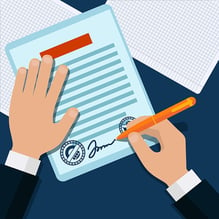Almost 15 years ago on June 30, 2000, President Bill Clinton signed into law the Electronic Signatures in Global and National Commerce Act (ESIGN Act), and the entire technological world rejoiced. (Well, we certainly did!)

What did we do before the ESIGN Act was signed? Well, online transactions were acceptable, yet muddled.Some businesses were using electronic signatures, but they weren’t sure whether those signatures were considered valid or legal.
Once the adoption of e-commerce technology spread both nationally and internationally, legislators were afraid that U.S. companies would fall behind global businesses unless Congress solidified the legality of e-commerce and specifically electronic signature technology.
The ESIGN Act allowed, and continues to allow, electronic signatures to have the same legality as a traditional ink signature. In fact, President Clinton used a digital signature to sign the act – albeit a cumbersome procedure 15 years ago.
Today, the electronic signature process is anything but cumbersome. In fact, it’s downright simple. The ESIGN Act ensured a legal foundation to stand upon, and most importantly, provided a platform for creativity and innovation that boosted growth across the digital landscape.
The ESIGN Act is purposely simple and non-technical. Although it does not favor one technology over another, companies and industries have often found that they need to raise the bar to ensure legal acceptance.
For example, in industries including healthcare, financial services and real estate, companies have the chance to say, “We need software that more than complies with the basic definition of ESIGN. We need e-signatures to last decades. We need a tamper-evident seal. We need a comprehensive audit trail.” That only scratches the surface.
Since ESIGN, digital innovators have embraced the value and possibility of e-signatures and created ways to use e-signature workflows in even the most highly regulated industries. With advanced authentication technology, like Knowledge-Based Authentication and secure digital signatures, even the most demanding processes can be executed using e-signatures.
Thanks to the foundation and influence of the ESIGN Act, we’re able to provide the security, speed and ease our digital world requires today. And for that, we kindly tip our hats to the ESIGN Act, as can all e-signature users who have enjoyed 15 years of e-signature innovation and its benefits of efficiency, security and cost-savings.
Want to learn more about what makes a digital signature legal? Download our free white paper “6 Questions to find out if a Digital Signature is Legal” today!
%20formatted-1.png?width=2528&height=739&name=SIGNiX%20Logo%20Main%20(white)%20formatted-1.png)

